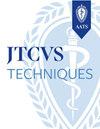Complex pediatric neoplasms: The role of congenital cardiothoracic surgery
IF 1.7
Q3 CARDIAC & CARDIOVASCULAR SYSTEMS
引用次数: 0
Abstract
Background
Surgery for pediatric solid neoplasms is often complicated by local tumor invasion. Cardiac surgeons can provide expertise in the chest and facilitate potentially aggressive management of tumors invading vasculature, pericardiac, or diaphragmatic spaces. Here we present 4 complex cases.
Methods
This descriptive retrospective chart review study included 4 surgical patients with locally invasive solid tumors.
Results
Case 1: 16 × 15.5 × 11 cm right chest synovial sarcoma in a male patient status post–neoadjuvant chemoradiation. Imaging revealed invasion of the right-sided subclavian vein, subclavian artery, phrenic nerve, and vagus nerve. The surgical approach via hemi-clamshell allowed for R0 resection. Case 2: Resection of a 17.6 × 10.5 × 8.1 cm sclerosing epithelioid fibrosarcoma originating from the vertebral body but causing aortic arch, right and left pulmonary artery, tracheal, and esophageal displacement. The surgeons preserved nearly all thoracic anatomy despite extensive periaortic and posterior mediastinal dissection. Case 3: Synchronous removal of a 11.5 × 9 × 5.5 cm pleuropulmonary blastoma at the time of tetralogy of Fallot repair. Case 4: Resection of a 12 × 0.5 × 0.3 cm nonviable Wilms tumor traversing from the right renal vein to the level of the Eustachian valve. All patients were extubated in the operating room and had an uneventful hospital course, with length of stay ranging from 5 to 10 days.
Conclusions
Pediatric patients may present with locally advanced heterogenous neoplasms. The added anatomic familiarity with the mediastinum, thoracic hilum, and great vessels in particular ensured safe resection in all cases. Thus, cardiothoracic surgery consultation is valuable when managing complex thoracic oncologic tumor resection.
复杂儿科肿瘤:先天性心胸外科的作用
背景小儿实体瘤手术通常会因局部肿瘤侵犯而变得复杂。心脏外科医生可以提供胸部方面的专业知识,并促进对侵犯血管、心包或膈肌间隙的肿瘤进行潜在的积极治疗。结果病例 1:16 × 15.5 × 11 厘米右胸部滑膜肉瘤,男性,新辅助化疗后状态。影像学检查显示肿瘤侵犯右侧锁骨下静脉、锁骨下动脉、膈神经和迷走神经。通过半腔镜手术方式进行了 R0 切除。病例 2:切除一个 17.6 × 10.5 × 8.1 厘米的硬化性上皮样纤维肉瘤,该瘤起源于椎体,但导致主动脉弓、左右肺动脉、气管和食管移位。尽管进行了广泛的主动脉周围和后纵隔剥离,外科医生还是保留了几乎所有的胸部解剖结构。病例 3:在法洛氏四联症修补术中同步切除一个 11.5 × 9 × 5.5 厘米的胸膜肺泡瘤。病例 4:切除一个从右肾静脉横穿至咽鼓管瓣水平的 12 × 0.5 × 0.3 厘米无法存活的 Wilms 肿瘤。所有患者均在手术室拔管,住院过程顺利,住院时间从 5 天到 10 天不等。对纵隔、胸腔脊柱和大血管的解剖熟悉程度尤其重要,这确保了所有病例的安全切除。因此,在处理复杂的胸部肿瘤切除术时,心胸外科会诊很有价值。
本文章由计算机程序翻译,如有差异,请以英文原文为准。
求助全文
约1分钟内获得全文
求助全文

 求助内容:
求助内容: 应助结果提醒方式:
应助结果提醒方式:


